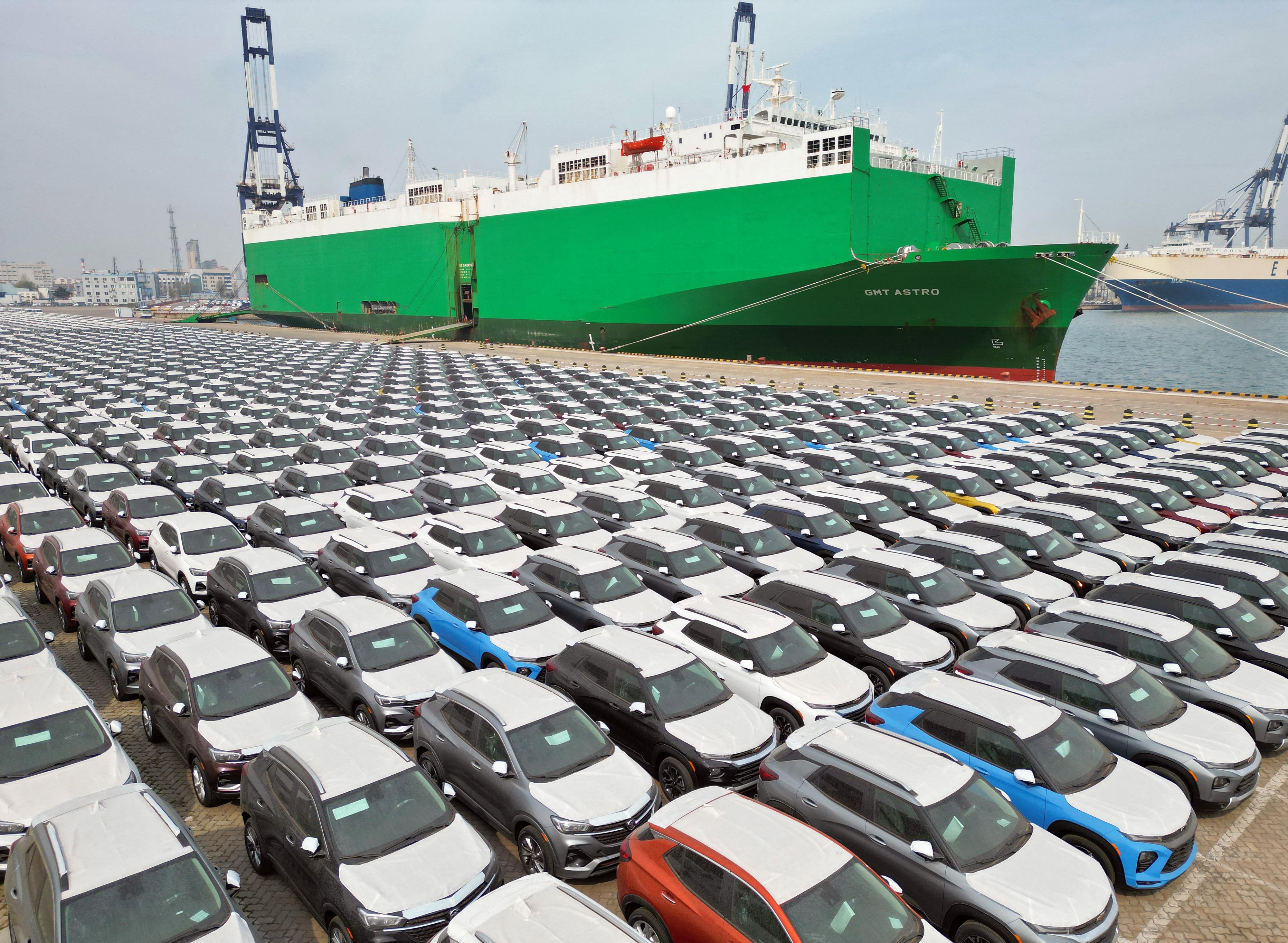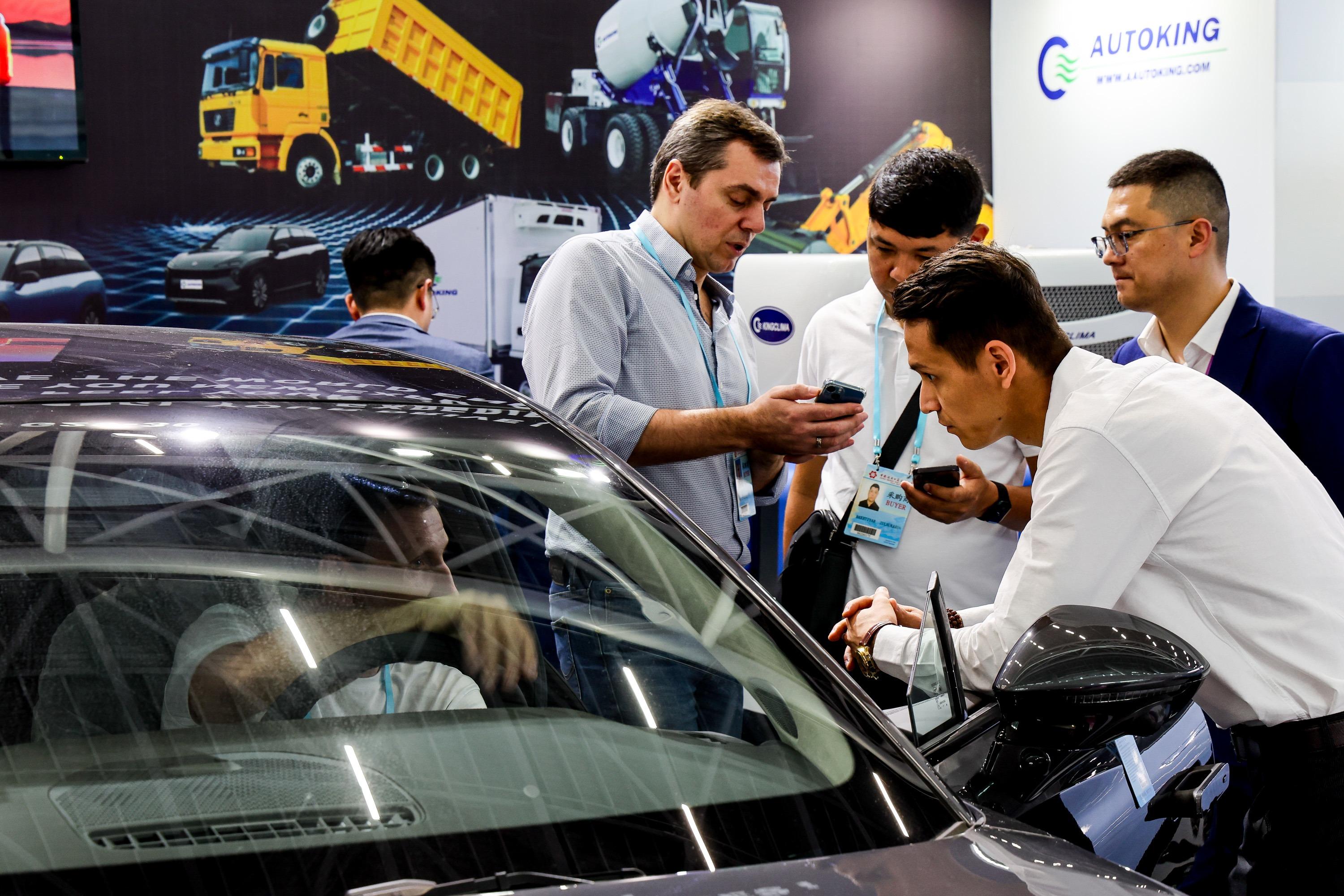Exporters ride policy support and FTAs, innovate, turn nimble and resilient for growth
 Cars for export wait to be loaded at Yantai Port in Yantai, Shandong province, on April 3. (TANG KE / FOR CHINA DAILY)
Cars for export wait to be loaded at Yantai Port in Yantai, Shandong province, on April 3. (TANG KE / FOR CHINA DAILY)
China's foreign trade is resilient in a challenging, uncertain environment as the players concerned continue to innovate and be nimble for steady growth, riding policy support for new growth points, observers said.
For instance, in November last year, Ding Yandong, president of Rollmax Shutter Component Co Ltd, a Ningbo, Zhejiang province-based roller shutter component manufacturer, rode into bad luck upon arrival at Heathrow Airport, London.
His hectic seven-day business trip was to take him to as many as six cities in England and Wales. The goal was to retain old customers and seek new orders. But, a local railway strike threw a spanner into his schedule, forcing him to hire an expensive taxi — some 300 pounds ($375.7) for the 220-kilometer London-Norwich stretch — to keep his appointment with his first client, a local manufacturer of smart home products.
Every pound was worth it and then some, Ding said, as the meeting went on for around five hours, during which product samples and their functions were thoroughly understood. The British client was also able to dispel his own lingering concerns about Rollmax's products. An expression of intent was signed on the spot that later led to a new business order.
"Our European clients are very straightforward and tend to express doubts initially about the quality of Chinese products. But their exacting standards and expectations actually help us to increase the added value of our products," said Ding, noting many misunderstandings can be easily resolved through face-to-face communication.
With China introducing fresh policy measures to stimulate exports and support domestic companies' industrial upgrade, as well as make better use of bilateral and free trade agreements to sustain its economic growth this year, Ding no longer has a dire need to travel abroad. His trips dropped in the first half of this year as more foreign buyers visited his factory in Ningbo over the past four months.
Like heads of many domestic companies, he has been busy booking booths at and participating in large trade shows such as the China Import and Export Fair (Canton Fair), the Appliance & Electronics World Expo and the China International Industry Fair to land more orders. He has also been spending a lot of time to develop cost-effective products for clients in Southeast Asia, Latin America and the Middle East.
Thanks to China's optimized COVID-19 management policy, the operation of new shipping routes and fast-growing business sectors like new energy vehicles and solar batteries, the country is expected to further vitalize companies in the foreign trade sector while forging stronger trade cooperation with developed as well as emerging economies, market watchers and government officials said.
They said such endeavors will expand and upgrade China's trade and also will be conducive to global economic recovery, amid negative factors like protectionism and geo-economic fragmentation.
 Purchasers get to know China's new energy vehicles during the 133rd China Import and Export Fair in Guangzhou, Guangdong province, on April 15. (PHOTO / XINHUA)
Purchasers get to know China's new energy vehicles during the 133rd China Import and Export Fair in Guangzhou, Guangdong province, on April 15. (PHOTO / XINHUA)
Supported by resurgent overseas demand, closer business ties with emerging markets and various efforts for industrial upgrade, China's foreign trade grew by 5.8 percent year-on-year to 13.32 trillion yuan ($1.92 trillion) in the first four months of 2023; exports rose 10.6 percent on a yearly basis to 7.67 trillion yuan, and imports edged up 0.02 percent year-on-year to 5.65 trillion yuan, data from the General Administration of Customs showed.
With many foreign retailers running out of stock since late last year, a large number of global businesspeople have started to order from Chinese exporters, said Bai Ming, deputy director of international market research at the Beijing-based Chinese Academy of International Trade and Economic Cooperation.
With inconvenient travel conditions of the last three years now a thing of the past, many of them are willing to visit China to participate in different trade fairs and visit factories, further easing concerns about the country's 2023 export outlook, Bai said, adding many Chinese exporters have also set up livestreaming studios within their factories, directly promoting a wide variety of products ranging from shoes to excavators to overseas buyers.
Rather than waiting for foreign trade orders to flow in, Huizhou Macc Electronics Co Ltd, an electronic component manufacturer in Guangdong province, dispatched a sales team to visit overseas clients in the Middle East, Europe, the United States and the Republic of Korea in the first quarter of this year.
"We are confident and highly motivated after a decent start in the first quarter. We will strive to increase our production value by 10 percent this year," said Zhang Qian, the company's general manager.
Acknowledging that the market environment has turned out to be more difficult than expected, he said several of the companies' previous clients from India, Vietnam and Turkiye have already transformed and grown. They have emerged as the company's strong rivals in the same market segment. Sales staff members from the new rivals even pretended to be potential customers and asked Zhang and his engineers highly technical questions at the company's booth during different exhibitions abroad.
"Of course, we didn't respond to such questions, but these emerging economies, supported by an increasingly sophisticated industrial system, combined with closer proximity to Europe and the ability to export duty-free products to many countries across the world, have gradually turned out to be competitors of Chinese exporters in the areas of medium and low-end manufacturing, he said.
Dealing with challenges posed by certain Western countries out to contain China's industrial chains, the country's manufacturing sector has become more aware of the subsequent challenges posed by such actions, said Lin Meng, director of the Modern Supply Chain Research Institute, which is part of the Beijing-based Chinese Academy of International Trade and Economic Cooperation.
As a result, China's drive for industrial upgrade has gained further impetus, augmenting the country's capabilities across various domains like the industrial chains related to new energy and green development, she said.
 Workers produce solar batteries for export at a photovoltaic enterprise in Lianyungang, Jiangsu province, on Jan 3. (SI WEI / FOR CHINA DAILY)
Workers produce solar batteries for export at a photovoltaic enterprise in Lianyungang, Jiangsu province, on Jan 3. (SI WEI / FOR CHINA DAILY)
SAIC Motor Corp Ltd, China's largest carmaker by sales, has been heading in that direction. The company said deliveries of its hatchback MG4 Electric reached 10,000 units in Europe in March.
There are now around 40,000 orders in Europe to be delivered, said Zhao Aimin, executive vice-president of SAIC International, noting one key ingredient of the group's success in overseas markets is its offer of the right products based on an understanding of local customers' demands.
To better meet the demand of overseas car buyers and potential customers, Zhao said he has a four-hour meeting with the company's research and development team each week.
Keen to facilitate more Chinese companies to ship their products to other parts of the world, China, a member of the Regional Comprehensive Economic Partnership agreement, is also seeking to join high-standard economic and trade agreements such as the Comprehensive and Progressive Agreement for Trans-Pacific Partnership and the Digital Economy Partnership Agreement, said Zhang Jianping, head of the center for regional economic cooperation at the Chinese Academy of International Trade and Economic Cooperation.
With the RCEP set to take effect in the Philippines — the last member economy to ratify of the agreement — on June 2, the agreement's complete implementation will help further bolster trade and investment between China and other participating countries, and will advance long-term prosperity and growth of the global economy, Zhang said.
According to Customs data, China's trade value with other RCEP signatory countries rose 7.3 percent year-on-year in the first quarter of this year.
Chinese authorities had issued 201,700 certificates of origin under the RCEP agreement by March. The certificates are related to exports valued at $8.41 billion, and are expected to reduce tariffs by $126 million for Chinese products in importing RCEP countries, data from Beijing-headquartered China Council for the Promotion of International Trade showed.
Certificates of origin are documents widely used in international trade transactions. They state that the products listed have met sufficient criteria to be considered as originating in a particular country. The issuance of these certificates is widely regarded as a barometer of foreign trade.
China had 457,000 companies with export and import records in the first quarter of this year, up 5.7 percent year-on-year, according to Customs data.
Wu Haiping, director-general of the General Administration of Customs' department of general operations, said that in order to address the difficulties and bottlenecks faced by foreign-trade enterprises, the Customs authority will focus on improving trade facilitation, streamlining import and export logistics, optimizing the business environment at ports, reducing enterprises' cost burdens and supporting the development of new foreign trade formats.
"We will continuously enrich, adjust and improve relevant measures and explore new Customs support initiatives to support China's foreign trade this year," he said, adding that 90,000 companies registered in the first quarter to engage in export and import activities, up 59.8 percent year-on-year.
zhongnan@chinadaily.com.cn